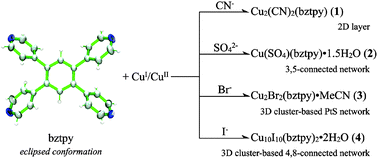Anion-dependent construction of copper(i/ii)-1,2,4,5-tetra(4-pyridyl)benzene frameworks†
Abstract
The unique

* Corresponding authors
a
Key Laboratory of Bioinorganic and Synthetic Chemistry of Ministry of Education, State Key Laboratory of Optoelectronic Materials and Technologies, School of Chemistry & Chemical Engineering, Sun Yat-Sen University, Guangzhou, China
E-mail:
tongml@mail.sysu.edu.cn
b Faculty of Chemical Engineering and Light Industry, Guangdong University of Technology, Guangzhou, China
The unique

 Please wait while we load your content...
Something went wrong. Try again?
Please wait while we load your content...
Something went wrong. Try again?
S. Hu, Z. Zhang, Z. Meng, Z. Lin and M. Tong, CrystEngComm, 2010, 12, 4378 DOI: 10.1039/C0CE00141D
To request permission to reproduce material from this article, please go to the Copyright Clearance Center request page.
If you are an author contributing to an RSC publication, you do not need to request permission provided correct acknowledgement is given.
If you are the author of this article, you do not need to request permission to reproduce figures and diagrams provided correct acknowledgement is given. If you want to reproduce the whole article in a third-party publication (excluding your thesis/dissertation for which permission is not required) please go to the Copyright Clearance Center request page.
Read more about how to correctly acknowledge RSC content.
 Fetching data from CrossRef.
Fetching data from CrossRef.
This may take some time to load.
Loading related content
